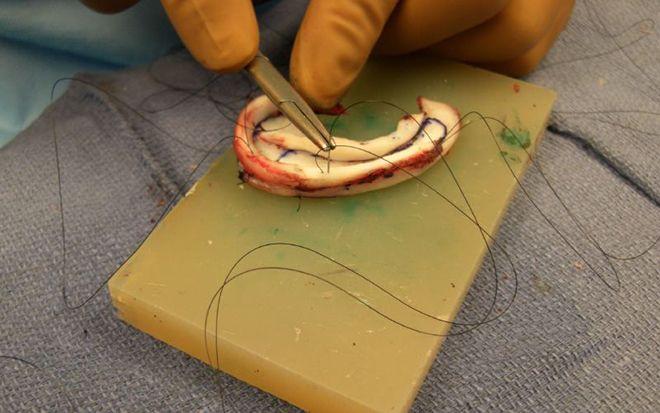Ear deformities, also known as ear malformations or ear anomalies, include a wide range of birth defects that ultimately cause ears to be misshapen, deformed, or absent at birth. Dr. Charles Thorne has over 25 years of experience in the treatment of ear deformities, and can reconstruct a new ear for patients at his New York City practice. Dr. Thorne has provided considerable success for patients with microtia, Stahl’s ear, hemifacial microsomia, cryptotia, question mark ears, prominent ears, and macrotia, as well as post-traumatic deformities and several other conditions.

Dr. Thorne creating an ear framework from the patient’s rib cartilage for reconstruction of microtia.
Microtia can affect one or both ears, and is categorized into four different types, grades one through four.
Microtia: A congenital birth defect, microtia causes one or both ears to be malformed or completely absent. These defects can, and usually do, cause impaired hearing as well as self-consciousness associated with the appearance. Microtia most commonly appears in boys and is more common on the right side but can occur in either sex and on either side. As mentioned in the section on “Microtia” above, there is tremendous variation in the appearance of microtia. There are a number of classifications used to describe the severity of microtia but, from a practical point of view, the ear either looks acceptable to the patient or it doesn’t and if it doesn’t, then Dr. Thorne can help by reconstructing the auricle.
Hemifacial Microsomia: This condition is characterized by underdevelopment of the tissues on one, or rarely both, sides of the face. The ear, jaw bones, soft tissue and nerves can be affected. In some patients the asymmetry is barely noticeable and in others it is severe. The cause of hemifacial mircosomia is unknown. The sequence of treatment is based on the severity of the asymmetry. Dr. Thorne examines the patient with his team of physicians and specialists and, in consultation with the patient and family, the treatment plan is developed.
Stahl’s Ear: This condition involves the development of an extra ridge of cartilage, and can produce a pointed or "Dr. Spock" appearance of the ear. Correction can be performed at any age after 4 years.
During your consultation, Dr. Thorne will determine which course of reconstruction is best for you or your child. Possible treatments may include:
Rib Cartilage Ear Reconstruction: Since the normal ear consists of skin overlying a flexible cartilage framework, it makes sense to use cartilage when reconstructing an ear. As shown in the image above, cartilage from the rib cage is spliced together to create a realistic framework. The framework is constructed do that it is the same size as the existing ear on the other side and is placed in a skin pocket, taking care that the position and angle are correct.
Medpor Framework and Prosthetic Ear Reconstruction: One of the alternatives to using the patient’s own cartilage is to use an artificial framework composed of polyethylene, known as Medpor. The procedure has the advantage of avoiding the scar and possible indentation on the chest, but the material is a hard, plastic substance and is not flexible. In addition, if the framework is exposed due to trauma from sports or other activities, it may not heal the way an ear made from the patient’s own tissues would heal. In general, Dr. Thorne believes that if a surgeon can carve a realistic framework from the patient’s cartilage, then that is a better option than using a foreign material.
Prosthetic Ear Reconstruction: Prosthetic reconstruction involves creation of an entirely artificial ear as one might see in a wax museum. The artificial ear is attached to the side of the head with glue or with titanium implants much like those used to attach dentures. Prosthetic ears can be made very realistic but most patients, particularly young ones, will not wear them. Prostheses are a daily reminder that something is wrong rather than a solution that allows the patient to move on. Prosthetic reconstruction can be very helpful for older patients who have lost an ear or part of an ear from skin cancer and would like a prosthesis for social events. The other disadvantage of prosthetic ears is that they have to be replaced every few years for the life of the patient.
Dr. Thorne understands the impact that ear deformities can have on a patient and a family. It is his mission to provide state-of-the-art surgical care for patients with ear malformations and he has been doing so for three decades.
Dr. Thorne also stays at the cutting edge of technology research and would be happy to present to you the current state of science and the future possibilities of bioprinting an ear framework from the patient’s own ear cartilage. This process is not available now but may be in the future.
Contact our office to schedule your personal consultation.

Dr. Thorne is the Editor-in-Chief and the author of several chapters in Grabb and Smith's PLASTIC SURGERY, 7th Edition.







